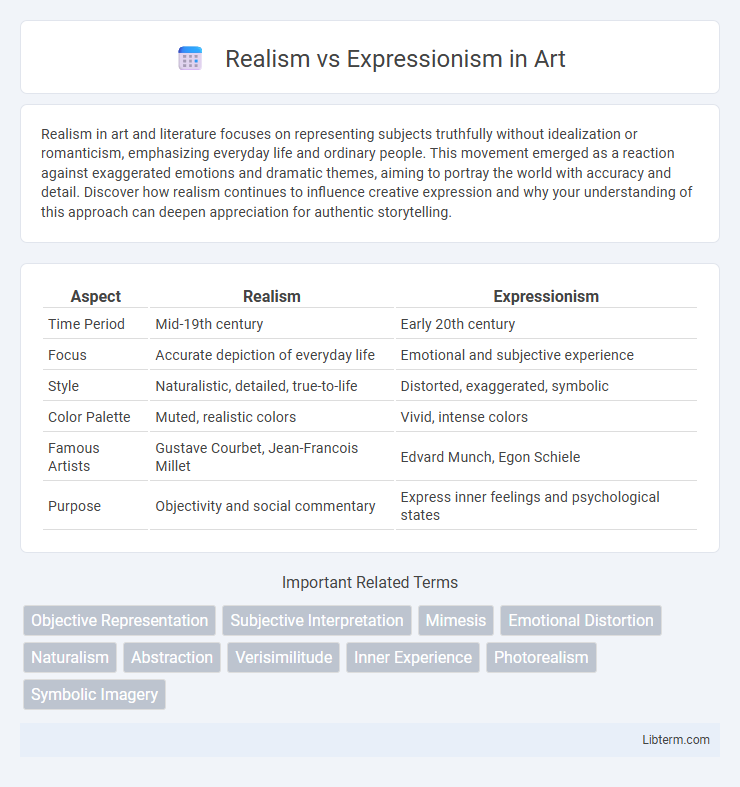Realism in art and literature focuses on representing subjects truthfully without idealization or romanticism, emphasizing everyday life and ordinary people. This movement emerged as a reaction against exaggerated emotions and dramatic themes, aiming to portray the world with accuracy and detail. Discover how realism continues to influence creative expression and why your understanding of this approach can deepen appreciation for authentic storytelling.
Table of Comparison
| Aspect | Realism | Expressionism |
|---|---|---|
| Time Period | Mid-19th century | Early 20th century |
| Focus | Accurate depiction of everyday life | Emotional and subjective experience |
| Style | Naturalistic, detailed, true-to-life | Distorted, exaggerated, symbolic |
| Color Palette | Muted, realistic colors | Vivid, intense colors |
| Famous Artists | Gustave Courbet, Jean-Francois Millet | Edvard Munch, Egon Schiele |
| Purpose | Objectivity and social commentary | Express inner feelings and psychological states |
Introduction to Realism and Expressionism
Realism emerged in the mid-19th century as an art movement emphasizing accurate, detailed depictions of everyday life and ordinary people, rejecting idealization and romanticism. Expressionism, developing in the early 20th century, prioritized emotional experience, using vivid colors and distorted forms to convey subjective feelings and inner turmoil. Both movements significantly influenced modern art by challenging traditional representation and exploring deeper human realities.
Historical Background of Realism
Realism emerged in the mid-19th century as a reaction against Romanticism, emphasizing accurate, unidealized depictions of everyday life and ordinary people. Rooted in the social and political upheavals of the 1848 European revolutions, Realist artists sought to highlight contemporary social issues and the lived experiences of the working class. Key figures like Gustave Courbet and Jean-Francois Millet pioneered this movement by rejecting dramatic subject matter in favor of truthful representation grounded in observation.
Origins and Evolution of Expressionism
Expressionism originated in early 20th-century Germany as a reaction against the detailed representation and objective reality of Realism, emphasizing emotional experience over physical accuracy. It evolved through movements such as Die Brucke and Der Blaue Reiter, using vivid colors and distorted forms to express inner feelings and subjective perspectives. This artistic shift marked a departure from Realism's focus on social conditions and external environments toward exploring psychological depth and existential angst.
Core Principles of Realism
Realism emphasizes accurate, unembellished depiction of everyday life and ordinary people, prioritizing objective observation over emotional subjectivity. Its core principles include detailed representation, social critique, and the rejection of idealization or romantic exaggeration. Realist artists strive to portray reality as it is, highlighting mundane moments and societal conditions with clarity and honesty.
Defining Features of Expressionism
Expressionism emphasizes intense emotional experience rather than physical reality, characterized by distorted forms, vivid colors, and dynamic brushstrokes that convey inner turmoil and subjective perspective. This movement prioritizes the artist's emotional response over realistic representation, often depicting anxiety, alienation, and psychological depth. Key elements include exaggerated imagery, symbolic content, and a departure from naturalistic accuracy to evoke mood and ideas.
Key Artists and Works in Realism
Key artists in Realism include Gustave Courbet, whose work "The Stone Breakers" epitomizes the movement's focus on depicting everyday life with unidealized detail. Jean-Francois Millet's painting "The Gleaners" highlights rural labor and social realities, reinforcing Realism's commitment to social commentary. Edouard Manet's "Olympia," while bridging Realism and Impressionism, challenged traditional subjects through its candid representation and remains a cornerstone in Realist art history.
Influential Expressionist Artists and Artworks
Expressionism, characterized by its emphasis on emotional intensity and subjective perspective, was shaped by influential artists such as Edvard Munch, whose iconic work "The Scream" epitomizes the movement's exploration of psychological distress. Ernst Ludwig Kirchner, a leading figure of the Die Brucke group, advanced Expressionism through dynamic compositions and vivid color palettes, as seen in "Street, Berlin." These artists contrasted sharply with Realism's commitment to depicting everyday life objectively, making Expressionism a pivotal response that prioritized inner experience over external reality.
Contrasting Techniques and Styles
Realism emphasizes detailed, lifelike depiction using precise lines, natural colors, and accurate perspectives to represent everyday scenes authentically. Expressionism, by contrast, employs distorted forms, exaggerated colors, and dynamic brushstrokes to evoke emotional intensity and subjective experiences rather than realistic accuracy. These contrasting techniques highlight Realism's commitment to objective representation versus Expressionism's focus on conveying inner feelings and psychological states.
The Impact of Realism and Expressionism on Modern Art
Realism revolutionized modern art by emphasizing accurate, unembellished depictions of everyday life, fostering a deeper connection between art and social reality. Expressionism, with its bold use of color and distorted forms, challenged traditional aesthetics by prioritizing emotional experience over objective representation. Together, these movements expanded artistic boundaries, influencing diverse styles such as abstract expressionism and social realism, and reshaping the trajectory of 20th-century art.
Conclusion: Legacy and Contemporary Relevance
Realism's legacy endures in its commitment to depicting everyday life with authentic detail, influencing documentary filmmaking and social commentary. Expressionism continues to inspire contemporary art and cinema through its emphasis on emotional intensity and subjective experience. Both movements shape modern creative expressions by balancing objective representation and personal interpretation.
Realism Infographic

 libterm.com
libterm.com